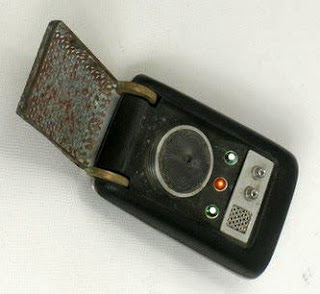 |
| Every Star Trek item featured on this PP postcard his been pulled. |
Phaser 1
Phaser 2
Tricorder
Communicator
Uhura's Pen
Tribble
When these pieces were initially announced a few weeks ago, I was skeptical regarding their authenticity, to say the least (read about it here). Luckily, Premiere was contacted by THE experts on original series props, Herocomm.com, an organization with a mission statement that inclues the following:
"HeroComm is a free and open library of all knowledge that can be gathered on The Original Series Star Trek classic communicator prop. We endeavor through scientific rigor to sort fact from fiction, history from hearsay, and originals from fakes."
While their specialty is TOS Communicators, they also know a lot about the other key TOS props. I can verify from first-hand knowledge that Herocomm lives up to it's mission. When I was working on verifying a TOS Klingon Disruptor, one of their members was a great help. Their process is ruthlessly fact-based and I gratefully endorse it.
Here's what Herocomm told me about their contact with Premiere (reproduced here with their permission). "ME" refers to "Mark English" a known forger of Star Trek props in the 70's and 80's:
"The full credit for pulling from sale what were obvious ME fakes goes to Daniel Levin at Premiere Props. When we initially informed his company of the forgery status of the communicator, he cordially reached out to us and got the information needed to satisfy himself, not just for the comm but the P1, P2 and tricorder.
In asking for a few key tells, these were the things we pointed out to Dan:
COMMUNICATOR – excessively corroded antenna, mic grill the wrong material, moiré pattern does not match any known undiscovered versions.
P1 – wrong shape (too narrow), the setting window not yellowed, the metal dial too shiny.
P2 – there is no reason for a black/white phaser to ever exist today. All would have been painted grey in Season One.
TRICORDER – no surviving tricorder would have the center compartment "computer disks” and moire as seen in “City on the Edge.” They were removed before Season 2 in Wah’s two and not replicated in the later fiberglass copies. Also rhinestones used instead of watch crowns or painted pin heads.
As it turns out, that batch of TOS props all came from a single owner, and Mr. Levin said they would be returned to that individual.
In fairness, it should be noted we Trek prop geeks take for granted our wealth of arcane knowledge. “Of course that’s a Mark English,” anyone here would say. But imagine being on the outside, where that name means nothing. Items that look good enough come in with a previously assigned CA, just like what happens every day with other prop collections, and, boom, on the sales block it goes. That that didn’t happen this time is a remarkable occurrence. This may very well be the first time ever a major house has cancelled the planned auction of alleged classic Star Trek props due to early fan intervention.
Simply, we were delighted to see action put behind Premiere Prop’s verbal commitment to offer only true genuine items, and we hope this marks a new era of mutual cooperation between auction houses and the many highly-qualified Internet-based experts out there."
While I also applaud PP's willingness to pull the items in question, it still leaves a huge credibility gap for PP going forward. If you're in the prop selling business, you'd have to live under a rock to not know at least the basics of Star Trek prop forgery – ie: that there's a TON of it – and spend at least a small bit of time authenticating such important (and expensive!!) items. It's not like there's a dearth of information out there with HC being at the top of that list. These items would have sold for far more than $100,000 had they been real, and that's something worth doing even the most basic of due diligence for. Beyond the TOS props, calling a yellow TNG uniform a "Data" without a sewn-in tag, or screen matching or solid provenance is also problematic. A real season 1-2 Data uniform could go well in excess of $5000. A no-name background goes for less than $1000.
I can't give Premiere much credit for pulling stuff that they could possibly get sued for later – that's business 101. Had they come to HC BEFORE they put the Trek stuff into their auction, I would applaud them loudly. But IMO, they put those items in there hoping that no one would raise to much fuss about them and they could make some easy cash. And you don't get a slap on the back for that.
I've been told that, because of this experience, Premiere will be instituting new steps to help ensure authenticity of items they sell in the future. Naturally, I think that's a good idea. I also think it's long overdue, though. Shouldn't authenticity be THE key component from day one for ANYONE selling original props and costumes? It should be, but alas, it isn't. Even the biggest, most prestigious of prop sellers, Christie's, recently offered some items that were obvious fakes. Profiles In History, a well-known auction house for movie props has repeatedly offered fakes, in some cases actually featuring them on the cover of their catalogs! On the flip side, Propstore of London does a great job of doing due diligence, so through their example we know it can be done.
Sometimes, debunking or authenticating a prop or costume can be difficult. But many times it can be done in just a few minutes. The Premiere stuff definitely falls into the "easier" category since there's so much information now available on the web.
I hope that Premiere will actually follow through with a new authentication policy. It would be a boon to the hobby and to collectors everywhere.
LLAP
Don


No comments:
Post a Comment